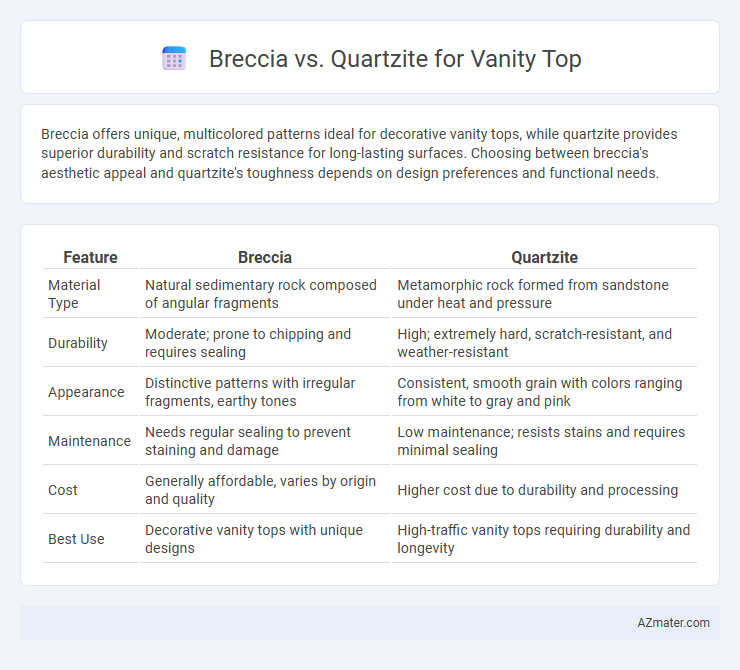Breccia offers unique, multicolored patterns ideal for decorative vanity tops, while quartzite provides superior durability and scratch resistance for long-lasting surfaces. Choosing between breccia's aesthetic appeal and quartzite's toughness depends on design preferences and functional needs.
Table of Comparison
| Feature | Breccia | Quartzite |
|---|---|---|
| Material Type | Natural sedimentary rock composed of angular fragments | Metamorphic rock formed from sandstone under heat and pressure |
| Durability | Moderate; prone to chipping and requires sealing | High; extremely hard, scratch-resistant, and weather-resistant |
| Appearance | Distinctive patterns with irregular fragments, earthy tones | Consistent, smooth grain with colors ranging from white to gray and pink |
| Maintenance | Needs regular sealing to prevent staining and damage | Low maintenance; resists stains and requires minimal sealing |
| Cost | Generally affordable, varies by origin and quality | Higher cost due to durability and processing |
| Best Use | Decorative vanity tops with unique designs | High-traffic vanity tops requiring durability and longevity |
Introduction to Breccia and Quartzite Vanity Tops
Breccia vanity tops feature a unique, fragmented stone pattern composed of angular rock fragments cemented together, offering a bold and artistic aesthetic ideal for modern or rustic bathroom designs. Quartzite vanity tops are formed from natural sandstone that has undergone intense heat and pressure, resulting in a highly durable, heat-resistant surface with subtle veining and a polished finish that mimics marble. Both options provide durable and visually striking choices, with breccia emphasizing dramatic, textured appeal and quartzite delivering a sleek, elegant look suitable for high-traffic bathroom areas.
Geological Formation and Composition
Breccia is a sedimentary rock composed of angular fragments cemented together by a fine-grained matrix, formed through mechanical weathering and rapid deposition processes. Quartzite is a metamorphic rock resulting from the recrystallization of pure quartz sandstone under intense heat and pressure, leading to a dense, hard texture. The distinct geological formation of breccia yields a fragmented, varied appearance, while quartzite's metamorphic origin provides a consistent, crystalline structure ideal for durable vanity tops.
Visual Appearance and Color Variations
Breccia vanity tops showcase a striking visual appearance with irregular fragments of various stones creating a dramatic, mosaic-like pattern, often featuring warm earth tones and bold contrast. In comparison, quartzite offers a smoother, more uniform aesthetic with subtle veining and color variations that range from soft whites and grays to rich golds and blues. The choice between breccia and quartzite depends on whether a homeowner prefers a vibrant, dynamic surface or a more consistent, elegant look for their bathroom vanity.
Durability and Hardness Comparison
Breccia, characterized by its fractured and angular fragments cemented together, offers a unique aesthetic but tends to be less durable and more prone to chipping compared to quartzite. Quartzite, formed from tightly fused quartz grains, exhibits superior hardness typically around 7 on the Mohs scale, making it highly resistant to scratches and impact, ideal for high-traffic vanity tops. While breccia's composition can vary, quartzite consistently provides enhanced durability and longevity, ensuring a robust surface for bathroom or kitchen applications.
Maintenance and Care Requirements
Breccia vanity tops require regular sealing to prevent staining due to their porous nature, along with gentle cleaning using pH-neutral products to avoid surface damage. Quartzite vanity tops are more durable and resistant to scratches and heat, needing only occasional sealing and mild soap for everyday cleaning to maintain their polished look. Both materials benefit from wiping spills immediately to preserve their appearance and longevity in bathroom environments.
Cost and Affordability
Breccia granite vanity tops typically cost between $50 to $150 per square foot, offering a luxurious appearance with unique vein patterns that justify the higher price point. Quartzite, known for its durability and resemblance to marble, generally ranges from $60 to $120 per square foot, making it a cost-effective choice for homeowners seeking both elegance and long-term value. Affordability considerations should include installation expenses and maintenance, where quartzite requires less upkeep compared to the more porous breccia, influencing overall cost efficiency.
Resistance to Stains and Scratches
Breccia offers moderate resistance to stains and scratches due to its natural porosity and composite structure, which requires regular sealing to maintain durability on vanity tops. Quartzite provides superior scratch resistance and low porosity, making it highly resistant to staining and ideal for high-traffic bathroom surfaces. Choosing quartzite ensures a more durable, long-lasting vanity top with easier maintenance compared to breccia.
Installation Process and Considerations
Breccia and quartzite vanity tops require careful installation to ensure durability and aesthetic appeal, with quartzite demanding precise handling due to its hardness and brittleness, often necessitating specialized cutting tools. Breccia, known for its unique fragmented pattern, can be more forgiving during installation but requires thorough sealing to prevent staining from bathroom moisture. Both materials need a stable, level substrate and professional installation to manage their weight and maintain surface integrity over time.
Best Applications for Breccia vs Quartzite
Breccia, with its bold patterns and multicolored fragments, is ideal for vanity tops in modern or eclectic bathroom designs where a unique, artistic statement is desired. Quartzite, known for its durability, resistance to scratches, and consistent coloration, suits high-traffic vanity tops requiring a balance of luxury and functionality. For wet areas prone to staining, quartzite's low porosity makes it preferable over breccia, which often requires more maintenance and sealing.
Final Verdict: Which Is Better for Your Vanity Top?
Breccia offers a unique, dramatic pattern with irregular fragments that add a custom look, while quartzite provides exceptional durability and resistance to scratches and heat, making it ideal for vanity tops exposed to daily wear. Quartzite's non-porous nature requires less maintenance compared to breccia, which often needs sealing to prevent stains and moisture damage. For a vanity top balancing beauty, longevity, and low upkeep, quartzite is generally the better choice.

Infographic: Breccia vs Quartzite for Vanity Top
 azmater.com
azmater.com